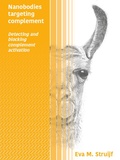Nanobodies targeting complement
Detecting and blocking complement activation

Struijf, Eva
- Promoter:
- Prof.dr. S.H.M. (Suzan) Rooijakkers
- Co-promoter:
- Dr. B.W. (Bart) Bardoel & dr. D.A.C. (Dani) Heesterbeek
- Research group:
- Rooijakkers
- Date:
- November 29, 2023
- Time:
- 10:15 h
Summary
The complement system is an important part of the human immune system that fights invading pathogens and removes apoptotic host cells, tumor cells and immune complexes. It consists of roughly 30 proteins that circulate in the blood and other body fluids and its activity is driven by proteolytic cascades and conformational changes. The role of the complement system in health and disease is extensively being studied. Although huge progress is made in the last decades, there are still major fundamental and clinical questions that yet remained unanswered. Novel tools and therapeutics that can inhibit, and/or discriminate complement precursor proteins from activation proteins are therefore still needed. We aimed to develop llama-derived nanobodies directed towards different complement components. In this thesis, we focused on central complement component C5 and activation products C3b and C5b6. To obtain complement targeting nanobodies, we immunized two llamas, created nanobody phage display libraries, and performed multiple rounds of phage display panning. For all complement proteins used during immunizations, we successfully identified multiple nanobodies. In the end, we prioritized four nanobodies for further characterization because of their potent binding and inhibitory activity or their unique capacity to discriminate activated complement products from their precursors. Briefly, UNbC3b-1 targeting C3b (chapter 2) specifically binds complement activation product C3b and not precursor C3 and efficiently inhibits alternative pathway convertase functioning. UNbC5-1 and UNbC5-2 (chapter 3) are two potent C5 inhibiting nanobodies that bind C5 on distinct sites. Using cryo-EM we identified the exact binding sites of UNbC5-1 and UNbC5-2 and showed that they overlap with the binding sites of known complement inhibitors eculizumab and RaCI3, respectively. Furthermore, we show that UNbC5-1 can also bind and inhibit a genetic variant of C5, called C5 R885H, which cannot be bound and inhibited by eculizumab. UNbC5b6-1 (chapter 4) is a nanobody that specifically binds to the complement activation complex C5b6, but not to precursor proteins C5 and C6. This nanobody does not interfere with complement activity. All in all, the here identified nanobodies can serve as tools to gain a better understanding of the molecular mechanisms of complement activation and hold promise for further development as diagnostic tools and therapeutics.